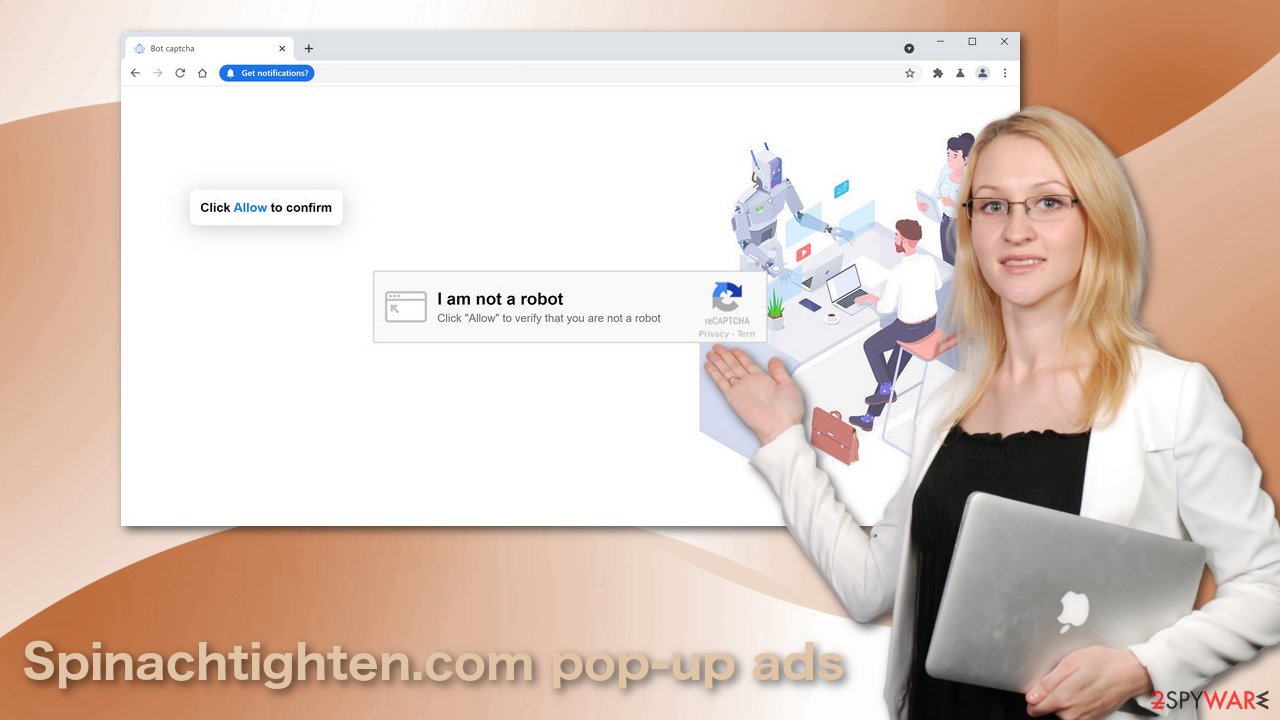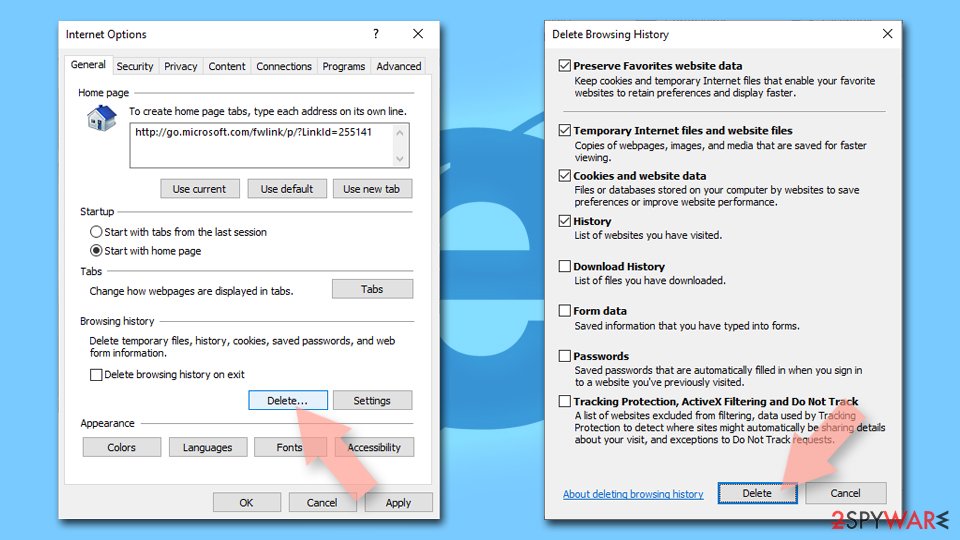Spinachtighten.com pop-up ads (fake) - spam
Spinachtighten.com pop-up ads Removal Guide
What is Spinachtighten.com pop-up ads?
Spinachtighten.com generates revenue by spamming you with ads

You can earn money by letting Google place ads on your website. Pages can also send push notifications straight to users' screens when they are not even browsing the website or using the browser. The appearance of these possibilities opened new doors to people who want to earn some passive income.
Spinachtighten.com is a fake website that does not provide any additional content besides having a false message displayed on its only page that is there to trick people into clicking the “Allow” button. These messages can say that people need to press the button to confirm their age, watch a video, prove they are not robots, or in order to download a file.
People fail to notice that the window that appears is from the browser itself, and it asks if you want the website to send you push notifications, or they do not know what it means. Push notifications are pop-up windows that appear in the corner from your screen. Websites and apps use this function to inform users about the latest news, updates, features. These notifications can also be used for advertising. This can become very annoying if they appear frequently.
People rarely stumble on pages like this through their search results. Usually, they end up on it because they already were visiting a shady website that uses many redirects[1] to generate revenue. Users click on random buttons without realizing they are ads that redirect to a random website.
| NAME | Spinachtighten.com |
| TYPE | Push notification spam; adware |
| SYMPTOMS | Pop-up ads appear on the screen even when the browser is closed |
| DISTRIBUTION | Deceptive ads, freeware installations, bundled software, shady websites |
| DANGERS | Advertisements can deceive users and lead to dangerous websites where they can provide sensitive information or download potentially unwanted programs or even malware |
| ELIMINATION | Most often, the removal can be achieved manually via browser settings |
| FURTHER STEPS | FortectIntego repair tool will scan the system for any damage left and fix it, as well as clear browsers automatically |
Users do not receive anything after clicking the “Allow” button; instead, they most likely get redirected to another similar page. If people are careless, they can get infected with ads from multiple pages like this.
Another thing is, the owners of Spinachtighten.com do not care about user safety; all they want is more clicks. So you will receive ads from a lot of different sources – legitimate and suspicious. It can be hard to identify which ads lead to harm, so you are at risk of getting interested, clicking on a promoted link, and sharing your personal information with the website. Sometimes this can have devastating consequences like identity theft.

It is best not to let random web pages show ads to you. The potentially dangerous websites you visit can gather information about you and provide it to third parties. It can also lead to you downloading potentially unwanted programs[2] or even malware.[3] You might see an ad for software that seems like a convenient tool, but do not believe anything you see on the internet – research before installing anything from an ad. Please read the reviews and make sure it is safe.
To get rid of annoying pop-up ads, you will have to do it manually by going to your browser settings. Below you will find instructions for the most popular browsers used today. Keep in mind that this method might not always work. If it fails, read the full article for other options.
Google Chrome (desktop):
- Open Google Chrome browser and go to Menu > Settings.
- Scroll down and click on Advanced.
- Locate the Privacy and security section and pick Site Settings > Notifications.
![Stop notifications on Chrome PC 1 Stop notifications on Chrome PC 1]()
- Look at the Allow section and look for a suspicious URL.
- Click the three vertical dots next to it and pick Block. This should remove unwanted notifications from Google Chrome.
![Stop notifications on Chrome PC 2 Stop notifications on Chrome PC 2]()
Google Chrome (Android):
- Open Google Chrome and tap on Settings (three vertical dots).
- Select Notifications.
- Scroll down to Sites section.
- Locate the unwanted URL and toggle the button to the left (Off setting).
![Stop notifications on Chrome Android Stop notifications on Chrome Android]()
Mozilla Firefox:
- Open Mozilla Firefox and go to Menu > Options.
- Click on Privacy & Security section.
- Under Permissions, you should be able to see Notifications. Click Settings button next to it.
![Stop notifications on Mozilla Firefox 1 Stop notifications on Mozilla Firefox 1]()
- In the Settings – Notification Permissions window, click on the drop-down menu by the URL in question.
- Select Block and then click on Save Changes. This should remove unwanted notifications from Mozilla Firefox.
![Stop notifications on Mozilla Firefox 2 Stop notifications on Mozilla Firefox 2]()
Safari:
- Click on Safari > Preferences…
- Go to Websites tab and, under General, select Notifications.
- Select the web address in question, click the drop-down menu and select Deny.
![Stop notifications on Safari Stop notifications on Safari]()
MS Edge:
- Open Microsoft Edge, and click the Settings and more button (three horizontal dots) at the top-right of the window.
- Select Settings and then go to Advanced.
- Under Website permissions, pick Manage permissions and select the URL in question.
![Stop notifications on Edge 1 Stop notifications on Edge 1]()
- Toggle the switch to the left to turn notifications off on Microsoft Edge.
![Stop notifications on Edge 2 Stop notifications on Edge 2]()
MS Edge (Chromium):
- Open Microsoft Edge, and go to Settings.
- Select Site permissions.
- Go to Notifications on the right.
- Under Allow, you will find the unwanted entry.
- Click on More actions and select Block.
![Stop notifications on Edge Chromium Stop notifications on Edge Chromium]()
Internet Explorer:
- Open Internet Explorer, and click on the Gear icon at the top-right on the window.
- Select Internet options and go to Privacy tab.
- In the Pop-up Blocker section, click on Settings.
- Locate web address in question under Allowed sites and pick Remove.
![Stop notifications on Internet Explorer Stop notifications on Internet Explorer]()
Websites track your browsing behavior
When you turn off Spinachtighten.com permissions in your settings, and it works, we recommend taking care of your browsers. This step can improve your machine's performance and will delete any information shady websites have collected about you with the help of cookies.
Nowadays, almost every website uses cookies to track your behavior, purchases, habits, interests to personalize your experience. This can be a good thing if it is done by legitimate websites that can be trusted. It feels uneasy if you know that a questionable website can take this information and provide it to whoever they want.
There is a very effective tool for this purpose that can do this automatically – FortectIntego. This way, you will not have to worry about not forgetting to do it and being calm because you will know that a program frequently takes care of your data. If you want to proceed with a manual method, we have a step-by-step guide below:
Clear cache and web data from Chrome:
- Click on Menu and pick Settings.
- Under Privacy and security, select Clear browsing data.
- Select Browsing history, Cookies, and other site data, as well as Cached images and files.
- Click Clear data.
![Clear cache and web data from Chrome Clear cache and web data from Chrome]()
MS Edge:
- Click on the Menu (three horizontal dots at the top-right of the browser window) and select Privacy & security.
- Under Clear browsing data, pick Choose what to clear.
- Select everything (apart from passwords, although you might want to include Media licenses as well, if applicable) and click on Clear.
![Clear Edge browsing data Clear Edge browsing data]()
Safari:
- Click Safari > Clear History…
- From the drop-down menu under Clear, pick all history.
- Confirm with Clear History.
![Clear cookies and website data from Safari Clear cookies and website data from Safari]()
Mozilla Firefox:
- Click Menu and pick Options.
- Go to Privacy & Security section.
- Scroll down to locate Cookies and Site Data.
- Click on Clear Data…
- Select Cookies and Site Data, as well as Cached Web Content, and press Clear.
![Clear cookies and site data from Firefox Clear cookies and site data from Firefox]()
Internet Explorer:
- Press on the Gear icon and select Internet Options.
- Under Browsing history, click Delete…
- Select relevant fields and press Delete.
![Clear temporary files from Internet Explorer Clear temporary files from Internet Explorer]()
Additional tips
If you were unsuccessful in deleting Spinachtighten.com from your browser's settings, there might be adware operating in the background without your knowledge. Use SpyHunter 5Combo Cleaner or Malwarebytes professional security tools to scan your machine and try to detect which program is responsible for unwanted behavior.
Or, if you know what you are doing, you can remove the program manually. Look for instructions at the bottom of the page.
Getting rid of Spinachtighten.com pop-up ads. Follow these steps
Uninstall from Windows
Instructions for Windows 10/8 machines:
- Enter Control Panel into Windows search box and hit Enter or click on the search result.
- Under Programs, select Uninstall a program.

- From the list, find the entry of the suspicious program.
- Right-click on the application and select Uninstall.
- If User Account Control shows up, click Yes.
- Wait till uninstallation process is complete and click OK.

If you are Windows 7/XP user, proceed with the following instructions:
- Click on Windows Start > Control Panel located on the right pane (if you are Windows XP user, click on Add/Remove Programs).
- In Control Panel, select Programs > Uninstall a program.

- Pick the unwanted application by clicking on it once.
- At the top, click Uninstall/Change.
- In the confirmation prompt, pick Yes.
- Click OK once the removal process is finished.
Delete from macOS
Remove items from Applications folder:
- From the menu bar, select Go > Applications.
- In the Applications folder, look for all related entries.
- Click on the app and drag it to Trash (or right-click and pick Move to Trash)

To fully remove an unwanted app, you need to access Application Support, LaunchAgents, and LaunchDaemons folders and delete relevant files:
- Select Go > Go to Folder.
- Enter /Library/Application Support and click Go or press Enter.
- In the Application Support folder, look for any dubious entries and then delete them.
- Now enter /Library/LaunchAgents and /Library/LaunchDaemons folders the same way and terminate all the related .plist files.

How to prevent from getting adware
Stream videos without limitations, no matter where you are
There are multiple parties that could find out almost anything about you by checking your online activity. While this is highly unlikely, advertisers and tech companies are constantly tracking you online. The first step to privacy should be a secure browser that focuses on tracker reduction to a minimum.
Even if you employ a secure browser, you will not be able to access websites that are restricted due to local government laws or other reasons. In other words, you may not be able to stream Disney+ or US-based Netflix in some countries. To bypass these restrictions, you can employ a powerful Private Internet Access VPN, which provides dedicated servers for torrenting and streaming, not slowing you down in the process.
Data backups are important – recover your lost files
Ransomware is one of the biggest threats to personal data. Once it is executed on a machine, it launches a sophisticated encryption algorithm that locks all your files, although it does not destroy them. The most common misconception is that anti-malware software can return files to their previous states. This is not true, however, and data remains locked after the malicious payload is deleted.
While regular data backups are the only secure method to recover your files after a ransomware attack, tools such as Data Recovery Pro can also be effective and restore at least some of your lost data.
- ^ Nick Altimore. Sneaky Redirects – What You Need To Know. SirLinksAlot. SEO Blog.
- ^ Kevin Townsend. The Battle With "Potentially Unwanted" Programs in the Enterprise. SecurityWeek. Cybersecurity News.
- ^ Malware | What is Malware & How to Stay Protected from Malware Attacks. PaloaltoNetworks. Threats.




















